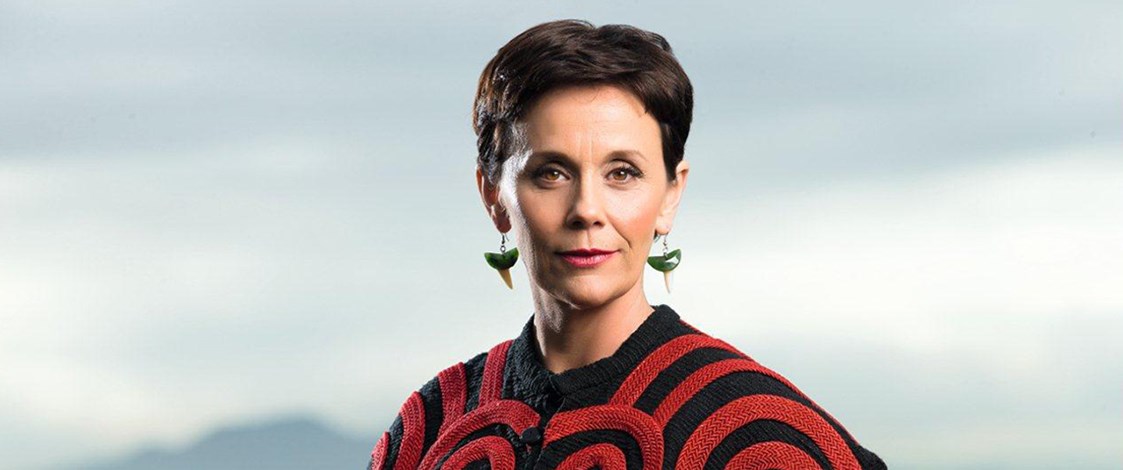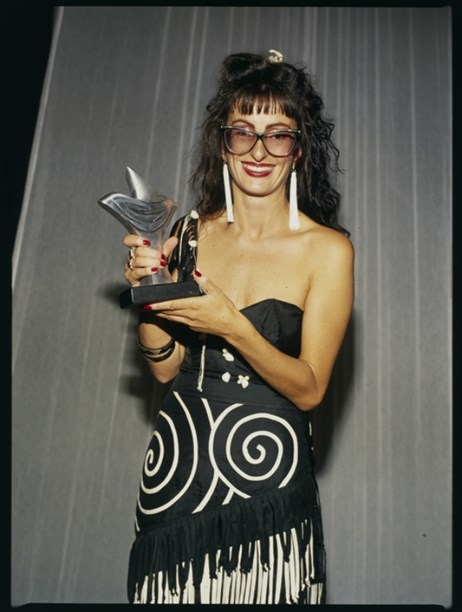Stories
Di Jennings
1952-

During their short creative partnership, the in-your-face style of designers Di Jennings and Kerrie Hughes made an indelible impact on high fashion of the late 1970s and early 80s. "You could not ignore a woman in a Svelt dress," laughs Di, reflecting on a time that she still holds dear.
Bordering at times on outrageous, Svelt’s theatrical statements reflected the radical 'second wave' feminism. Women were getting hold of the idea that they could be who they wanted to be, wear what they wanted to wear – be it dungarees or an over-the-top designer outfit.
A Svelt ensemble from 1981. This work is licensed under a Creative Commons Attribution-NonCommercial-ShareAlike 3.0 New Zealand License.
Former TV presenter and Svelt client Judith Fyfe has fond memories of wearing their outfits on air. "Svelt was a New Zealand fashion milestone that went where absolutely no one else did," she says, adding that she still has a couple of their outfits tucked away. "I kept them because I always thought that they were important. I considered that they were works of art that would in time become exhibits."
Di recalls the sheer joy of setting up their first boutique in Upper Cuba Street at the heart of the capital’s creative precinct. It was the highlight of a career that has taken her from the world of high fashion, through wearable art, to her current role in creative community development. There is some confusion about the spelling of the label. Was it Svelte or Svelt? Di quickly clears this up. "It was Svelte, but it actually changed because the person who designed our labels got the spelling wrong. We had to go without an 'e' for a while!"
These days Di is based in Raglan and she and Kerrie Hughes, (now in Lower Hutt after a successful career in London), are still the best of friends. "Kerrie and I were a great combination," she says. "We were young and passionate and we definitely had different styles but it meant that our shop covered an amazing array of looks."
"I think what we had in common was that we both loved going for broke. We didn’t have a design philosophy as such; we were just having a whole lot of fun being as creative as we could and being inspired by one another. If one did something incredibly fabulous, the other would have to match it – we spurred each other on."
Together they created fashion shows that gathered a bit of a cult following in Wellington. Di remembers herself as the organiser and loved inviting artists, musicians and dancers to get together and create an event that took on a life of its own. In some ways it was a precursor to wearable art shows – a field that she has been, and is still to some extent, involved in. At the time Di was the only Pākehā living in an all-Māori household. "I was influenced by all these fabulous gay Māori political radicals, going to their marae and all sorts of things."

Hiria Tumoana modelling a Svelt design in Cuba Street, Wellington. Photo by The Evening Post, 5 December 1981, courtesy of Alexander Turnbull Library, EP/1981/3947. Copyright unknown.
It gave her an edge that would herald a significant turning point in New Zealand design. "I don’t know if we were the first," Di recalls, "but we were certainly one of the first Pakeha designers to experiment with Māori and Polynesian designs." The first thing she made that had a Māori style was, she says, completely unconscious. “I just started playing with geometrics and black and white and some tassels. I took this thing home and one of my flatmates said to me, 'God Di, you’re a walking marae!' After that it did become more conscious."
She also counts strong union women and feminists amongst her friends at the time. "Looking back, creating such bold clothes says something about my politics. I feel that was probably the case even if it was unconscious. I’ve always been quite a political being." Di was born in Surrey, just outside London, in 1952. The family immigrated to Australia when she was 11 and spent her teenage years in Sydney.
"My mum was a fantastic sewer and made a lot of our clothes. As the youngest of three girls most of my clothes were hand-me-downs from my sisters, but Mum did make us some special things for weddings and occasions. I can remember every detail of those clothes. “In my early teen years I started to want to wear what I wanted to wear, so I’d design stuff and Mum would sew it up for me."
As a teenager in the 1960s, in a country that was sometimes hostile to English immigrants, style became Di’s way of showing the Aussies that coming from England was cool. "I was a mod – very Carnaby Street and Mary Quant! I had the Vidal Sassoon haircut and these wonderful geometric design clothes. And I think that period influenced my later design quite a lot."
At 20, she crossed the Tasman to visit an old school friend, fell in love with New Zealand and – apart from a more recent period of living in Scotland – has lived here ever since. In the early seventies Wellington was beginning to develop its own artistic cool. Di’s first foray into the fashion industry was selling her own designs from her stall at Victoria Market. She was also working for the Merchant Adventurers of Narnia, a hip, incense-fuelled treasure trove in Upper Willis Street which imported and retailed beautiful fabrics. Feeling that maybe she did have a bit of flair, Di enrolled in Wellington Polytechnic’s two-year clothing and textile course.
"I learnt an enormous amount and started to develop a style, and of course there I met the lovely Kerrie Hughes. We went into business together after we’d finished our Polytech course.” Svelte was launched in 1980 and, after a couple of heady years, Di and Kerrie set their sights on Auckland. They closed their Wellington shop and hit the big smoke – finding a central space in downtown Queen’s Arcade.
At the time, Di says, they probably didn’t appreciate the support and loyalty of their Wellington clientele. "Auckland wasn’t really our town. It took a lot to crack and I don’t know that we really did, to be honest. We were certainly embraced as up-and-coming with a certain reputation for highly original garments and I think we were quite well-received. I had a lovely relationship with the Zambesi people who had a shop quite close by. We got heaps of publicity in magazines like ChaCha and Pacific Way. We were single and out and about in the city wearing our own creations."
Among their clients were singers Trudi Green and Hinewehi Mohi, and others, many from the entertainment world, who wanted to 'strut their stuff’'in Svelt. Another client was furniture/product designer Michael Glock. "I remember when he got married I dressed his wife – she wore red, this absolutely over-the- top rose creation, and all the guests had to wear white!"
By 1985 the pair had gone their separate ways. Kerrie returned to Wellington to open Siren in 1986 and subsequently went to London where she established the Idol shop in Soho. Di gave birth to her son and continued her design work from home. While she and Kerrie had entered the Benson & Hedges Fashion Design Awards over their years together, Di says their stuff was always a little wild for the judges. However in 1989 as a solo designer under her own name, she won the Daywear section with a yellow coat and outfit. That same year she won the New Zealand Mohair Awards with an appliqued and beaded pantsuit.

Di Jennings won a Benson & Hedges Fashion Design Award for Daywear in 1989. Photo by Barry Durrant, image © Barry Durrant.
When the Wearable Arts Awards started in 1987, Di entered and won a number of awards as a designer in the early Nelson years, including the Pacific Paradise section and, in 1996, the Creative Excellence Award. She was also involved as a judge. By the 1990s, Di was ready to do something different. She completed a degree in Social Practice, majoring in Community Development. Subsequently her creative flair and organisational skills have been put to good use in her work in community enterprise development.
"In 2003 we did a collaborative piece for the Trash to Fashion Awards that brought together all the many cultures that lived in Ranui (West Auckland). A number of people worked on it and I did my best to hold the piece together to keep some kind of design integrity, and it won the Supreme Award. It was a collaborative piece. I’ve now moved into a collaborative world where it is really nice to bring my skills to a project without it being all about me."
Text by Katherine Findlay. Banner image © Di Jennings.
Last published January 2016.